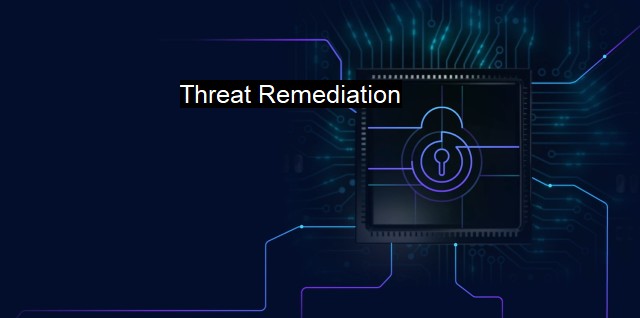What is Threat Remediation?
Threat Remediation: Mitigating Cybercrime and Enhancing Cyber Resilience for Organizations
Threat remediation in the context of cybersecurity and antivirus functions is a process that involves the systematic handling of detected threats, ensuring necessary steps are taken to counteract the potential impacts. Threats encompass any prospective conditions or activities that might significantly sabotage, steal, or damage precious information owned by individuals or corporations. These threats generally involve botnets, malware, viruses, hackers, and spyware, amongst others, which pose substantial risks to cybersecurity. Therefore, threat remediation embodies the entire systemized procedures relied upon to lessen, eliminate, repel, or otherwise alleviate these dangers.The cybersecurity domain utilizes threat remediation, which incorporates the entire methodology, right from recognizing and evaluating the threat to decisively reacting to it and neutralizing its potential impacts. It’s crucial to comprehend that this process is not static. It relies significantly on the changing dynamics of cyber risk landscapes forced by evolving cyber threats. Thus, consistent modifying and elaborating systems – to safeguard from simultaneously forming or expected threats – is crucial for proficient threat remediation.
Threat remediation in the cybersecurity domain generally implies several strategies. Primarily, an immediate response is necessitated as and when a threat is identified. Depending on the type and severity, adequate system modifications, or counteractive measure implementation should ensure the system’s safety. Once the countermeasures have been employed effectively, the system needs to be rechecked to confirm the threat elimination. preventive measures should be refined or added to impede similar problems from arising in future.
Relating to antivirus software, threat remediation involves tracing malicious applications or files, cordoning them off from your other files, and eradicating them altogether. The vital function of antivirus software is not only to hunt and dispose of threats but also learn from each encounter. Being adaptive is the critical aspect because, with time, threats evolve and become significantly more potent and generate greater harm.
Remediation remarkably is as much a proactive system as it is responsive. It implies that while it remediates threats, it also seeks to prevent, subsequently, similar threats. Actions imply maintaining data backups frequently, utilizing robust rock-solid firewalls, secure networks and conducting regular system updates. regular system audits greatly contribute to recognizing cybersecurity weaknesses, consequently refining threat remediation strategies.
Another significant aspect of remediation includes instigating secure password policies, restricting user access authority, physical security hits, or integrating the latest antivirus software. educating staff members can not be undermined. They need to be apprised of potential threats they can cause inadvertently, practices they need to avoid or safe phenomenons they would have to adopt.
Remediation might not always revolve around technological facets. Occasionally, identifying human error threats mandates the creation of safety guidelines and employee indoctrination about demonstrating reliable cyberspace behavior.
Threat remediation plays a critical role in averting potential cybersecurity threats and preventing the recurrence of similar threats. It underpins optimizing security configurations, routinely updating patches, eliminating vulnerabilities, and automated scanning systems. The objective of threat remediation is to minimize the ramifications of any cyber threat on a system's security, both promptly and in the future. As cybercriminals become increasingly proactive, astute, and resourceful, a potent threat remediation strategy remains an indispensable aspect of any cybersecurity initiative, given how devastating cybersecurity neglect repercussions might turn into. Threat remediation, hence, is a vital component of a proficient cybersecurity approach and concludes being not only a necessity but an outright obligation.

Threat Remediation FAQs
What is threat remediation?
Threat remediation refers to the process of identifying and removing or mitigating cyber threats that have been detected by cybersecurity systems or antivirus software. It involves a combination of automated and manual techniques to disinfect compromised systems and restore them to a secure state.What are the common types of threats that require remediation?
Some of the common types of threats that require remediation include malware infections, ransomware attacks, phishing scams, and data breaches. These threats can cause significant damage to an organization's IT infrastructure and compromise sensitive information, so it is crucial to respond to them promptly and effectively.What are the steps involved in threat remediation?
The steps involved in threat remediation typically include triage, containment, analysis, and remediation. Triage involves identifying the scope and severity of the threat, containment involves isolating the affected systems to prevent further damage, analysis involves investigating the root cause of the threat, and remediation involves removing the threat and restoring the affected systems to a secure state.How can organizations ensure effective threat remediation?
To ensure effective threat remediation, organizations should have a comprehensive incident response plan in place that outlines roles and responsibilities, escalation procedures, and communication protocols. They should also invest in sophisticated cybersecurity tools and technologies that can detect and respond to threats in real-time. Moreover, regular training and awareness programs can help employees recognize and report potential threats, minimizing the risk of a successful attack.| | A | | | B | | | C | | | D | | | E | | | F | | | G | | | H | | | I | | | J | | | K | | | L | | | M | |
| | N | | | O | | | P | | | Q | | | R | | | S | | | T | | | U | | | V | | | W | | | X | | | Y | | | Z | |
| | 1 | | | 2 | | | 3 | | | 4 | | | 7 | | | 8 | | |||||||